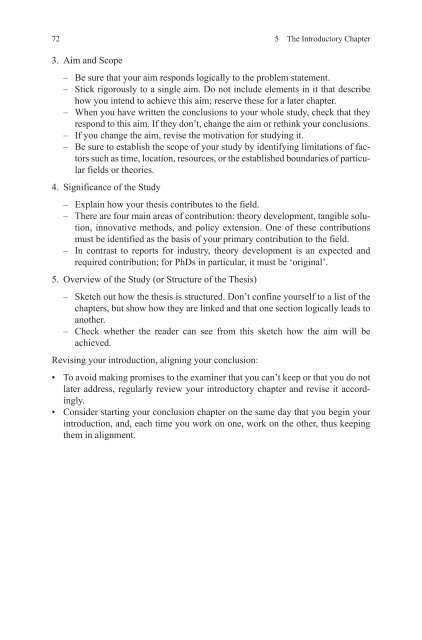How-to-Write-a-Better-Thesis
Create successful ePaper yourself
Turn your PDF publications into a flip-book with our unique Google optimized e-Paper software.
72<br />
5 The Introduc<strong>to</strong>ry Chapter<br />
3. Aim and Scope<br />
– Be sure that your aim responds logically <strong>to</strong> the problem statement.<br />
– Stick rigorously <strong>to</strong> a single aim. Do not include elements in it that describe<br />
how you intend <strong>to</strong> achieve this aim; reserve these for a later chapter.<br />
– When you have written the conclusions <strong>to</strong> your whole study, check that they<br />
respond <strong>to</strong> this aim. If they don’t, change the aim or rethink your conclusions.<br />
– If you change the aim, revise the motivation for studying it.<br />
– Be sure <strong>to</strong> establish the scope of your study by identifying limitations of fac<strong>to</strong>rs<br />
such as time, location, resources, or the established boundaries of particular<br />
fields or theories.<br />
4. Significance of the Study<br />
– Explain how your thesis contributes <strong>to</strong> the field.<br />
– There are four main areas of contribution: theory development, tangible solution,<br />
innovative methods, and policy extension. One of these contributions<br />
must be identified as the basis of your primary contribution <strong>to</strong> the field.<br />
– In contrast <strong>to</strong> reports for industry, theory development is an expected and<br />
required contribution; for PhDs in particular, it must be ‘original’.<br />
5. Overview of the Study (or Structure of the <strong>Thesis</strong>)<br />
– Sketch out how the thesis is structured. Don’t confine yourself <strong>to</strong> a list of the<br />
chapters, but show how they are linked and that one section logically leads <strong>to</strong><br />
another.<br />
– Check whether the reader can see from this sketch how the aim will be<br />
achieved.<br />
Revising your introduction, aligning your conclusion:<br />
• To avoid making promises <strong>to</strong> the examiner that you can’t keep or that you do not<br />
later address, regularly review your introduc<strong>to</strong>ry chapter and revise it accordingly.<br />
• Consider starting your conclusion chapter on the same day that you begin your<br />
introduction, and, each time you work on one, work on the other, thus keeping<br />
them in alignment.














![[Lonely Planet] Sri Lanka](https://img.yumpu.com/59845622/1/169x260/lonely-planet-sri-lanka.jpg?quality=85)


